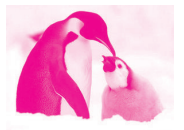Table of Contents
Passage
A The emperor penguin is an impossible bird. It breeds in the middle of winter in some of the coldest places on Earth, surviving temperatures as low as50 ℃ and hurricane-force winds. In March or April, just as the Antarctic winter begins, the birds waddle across the sea ice to their colonies, where they mate. After the egg is laid, the females head back to sea to feed, leaving the males behind to incubate it. By the time the females return in July or August, when the eggs hatch, the males will have spent almost four months huddling together in the bitter cold without eating, losing half of their body weight. This extraordinary lifestyle has made the emperors famous. They have even been held up as role models by evangelical Christians. But these breathtaking birds will soon have to face the one thing they haven’t evolved to cope with: warmth. Fast-forward a few decades, and many colonies will be on the road to extinction. Are we witnessing the last march of the emperor penguins?
B Finding out what’s going on with emperor penguins is a huge challenge as almost all of their colonies are exceedingly difficult to get to. In fact, it was only this year that the first global census of the birds was published, based on an automated analysis of satellite images by the British Antarctic Survey. This revealed four previously unknown colonies, bringing the total to 46 (see map), and put the number of adults at 600,000, nearly double earlier estimates. That might sound like good news, but it’s impossible to say whether the overall number of birds is rising or falling. “It’s simply that we now have a better method to find them-remote sensing,” says team member Phil Trathan.

C By far the most comprehensive insight into the highs and lows of emperor populations comes from just one colony, which happens to be next to the Dumont d’Urville research station on the Adelie coast of Antarctica. “After a snowstorm, they can see how many eggs have got frozen, and how many chicks have died,” says biologist Stephanie Jenouvrier of the Woods Hole Oceanographic Institution in Massachusetts, who studies the birds. This relatively small colony of 2500 birds featured in the 2005 blockbuster documentary March of the Penguins.
D The Dumont d’Urville emperor’s have been closely monitored since 1962. During the 1970s and early 80s, the average winter temperature was-14.7 ℃ , compared with a more typical-17.3℃ . This “warm spell” reduced the extent of winter sea ice by around 11 per cent-and the penguin population by half. “When sea ice decreased, it caused strong mortality of emperor penguins,” says Jenouvrier. Why are emperors so sensitive to changes in sea ice? Well to start with, most never set foot on land. They aren’t agile enough to scale the steep rocks and ice precipices that guard most of Antarctica’s shoreline. All but two of the 46 colonies are on fast ice-sea ice stuck fast to the shore. So if the sea ice forms late or breaks up early, it won’t last for the eight months or so these large birds need to breed and raise chicly
E “Early break-up of sea ice can cause catastrophic breeding failure,” says Trathan. Emperors live around 20 years, so colonies can survive a few bad breeding seasons, but persistent changes can be disastrous. What’s more, emperors moult every year in January or February. The birds would freeze to death if they tried to swim during the 30 or so days it takes to grow new feathers, so they must find ice floes to shelter on that are large enough to survive this period. This may be an even more demanding period in the emperors’ lives than the winter, because they have little time to fatten themselves up beforehand. “The adults are reliant on stable sea ice for moulting, and for me, that’s the greatest concern,” says Gerald Kooyman of Scripps Institution of Oceanography, one of the world’s leading emperor penguin biologists. “They don’t have any options. They have to moult.”
F Last, but not least, the source of much of the penguins’ energy, directly or indirectly, is krill-and krill also depend on sea ice. Young krill shelter and feed under it. “The sea ice is the basis of the Antarctic ecosystem,” says Jenouvrier. For now, there is still plenty of sea ice. In fact, the extent of Antarctic sea ice in winter has increased slightly over the last 30 years. This has been caused by stronger winds blowing sea ice further away from the land, with more ice forming in the open water exposed by this movement. The stronger winds are thought to be a consequence of ozone loss, rather than global warming.
G But unlike the Arctic Ocean, where thick sea ice used to survive from year to year, in Antarctica almost all the sea ice melts every year. That means the extent of winter sea ice changes rapidly in response to any change in conditions. This can be seen around the rapidly warming Antarctic Peninsula, where winter sea ice extent is falling 1 or 2 per cent each year. Here one small emperor colony, on the Dion Islands, has already died out. When it was discovered in 1948 it was home to 300 adults. By 1999,just 40 remained and 10 years later they were all gone. Though no one knows for sure what caused the colony’s demise, it coincided with a decline in the duration of winter sea ice. On the peninsula, populations of the other Antarctic native penguins, the Adelie and chinstrap, are also plummeting, probably because of the changing environment and declining krill. Matters haven’t been helped by an invasion of nonnative gentoo penguins, and other species like the king and macaroni penguins could follow.

H What’s happening on the peninsula today could be happening all around Antarctica in the decades to come. “With a doubling of greenhouse gas concentrations over the next century, we estimate that the extent of Antarctic sea ice would decrease by about one third, says John Turner, a climatologist with the British Antarctic Survey. Earlier this year the emperor penguin was added to the IUCN’s Red List for species threatened with extinction in the near future-“near” meaning in a century or two. When Jenouvrier’s team used the observations at Dumont d’Urville to predict what will happen as the continent warms, they concluded that the colony is likely to decline by 81 per cent by 2100 and be heading towards extinction .
I That is in line with a 2010 study by a team including Jenouvrier and David Ainley of the California-based ecological consultants H. T. Harvey and Associates. It predicted that all emperor colonies north of 70 degrees latitudeabout 35 per cent of the total population-would decline or disappear if the world warms by 2℃ , although a few colonies south of 73 degrees might grow a little. This might not sound too bad, but both these studies are based on what increasingly appear to be overly optimistic assumptions. If we continue as we are, the global temperature will climb above 2 ℃ before 2050, on course to a 5 or 6 ℃ rise by 2100. “If the earth warms by 5 or 6 degrees, I can’t see that there’s going to be much sea ice left anywhere on Earth,” says Ainley. And if the sea ice vanishes, the emperor penguins will vanish too.
Questions
Questions 1-6 Use the information in the passage to match the people (listed A-E) with opinions or deeds below. Write the appropriate letters A-E in boxes 1-6 on your answer sheet.
NB you may use any letter more than once
A Stephanie Jenouvrier
B Gerald Kooyman
C Phil Trathan
D David Ainley
E John Turner
1 Penguin breeding is threatened by sea ice melting in advance.
2 About 30% sea ice would disappear in the future.
3 Penguin needs constant sea ice for feather changing.
4 Dead chicks are easy to be counted after a storm.
5 No sea ice left in case global temperature increased certain degrees.
6 Sea ice provides foundation for Antarctic ecology.
Questions 7-10 Do the following statements agree with the information given in Reading Passage? In boxes 7-10 on your answer sheet, write
TRUE if the sataement agrees with the information
FALSE if the statement contradicts the information
NOT GIVEN if there is no information on this
7 It is the female emperor penguin that carried more incubation duty.
8 Evangelical Christian lives a similar lifestyle as penguin.
9 With the advanced satellite photographs, fluctuation of penguin number is easily observed.
10 Strong winds caused by Ozone depletion, blow away the sea ice.
Questions 11-13 Complete the following summary of the paragraphs of Reading Passage, using no more than two words from the Reading Passage for each answer. Write your answers in boxes 11- 13 on your answer sheet.
Summary
There are several reasons of why emperor penguins are vulnerable to sea ice transformation. First of all, they are not 11 ……………………….. to walk on steep rocks that all over Antarctica. They wouldn’t be able to breed. Next, emperors need to 12 ……………………….. at certain time of year, which protects them from been killed by freezing water. Finally, emperor penguin’s food called 13 ……………………….. is also connected to availability of sea ice.
Answers




Beginer